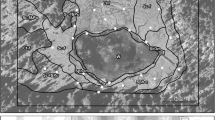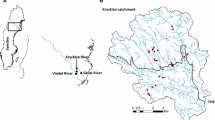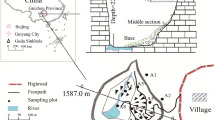Abstract
We investigated the importance of water chemistry and water regime for vascular plant and bryophyte species distribution in Western Carpathian mires dominated bySphagnum. Seventy-seven small circle plots distributed across a wide geographical area, a wide range of mineral richness and all possible microtopographical features were sampled in terms of species composition, physical-chemical water properties and water regime during one growing season. Both water chemistry and water regime were found to be important factors for vegetation composition. Bryophytes reflected only one clear gradient, connected to base-richness (pH, conductivity) and maximal water-level, whereas three different environmental gradients determined the occurrence of vascular plants: water-level amplitude, base-richness and an indistinct gradient presumably connected to peat layer thickness. When the entire data set was subjected to DCA ordination, the first resulting axis was governed by the bryophyte subset, whereas the second one was governed by the vascular plant subset. The species density of vascular plants was positively correlated with pH and conductivity. On the contrary, bryophyte species density showed no relationship to environmental factors. We further compared the pH values measured in groundwater and in water squeezed from bryophytes from the same plot; these plots were distributed along the base-richness gradient. Only in the acidic mires did the use of squeezed-water chemistry in the analyses give results similar to the use of groundwater pH. Further, we found thatSphagnum species with a similar response to the base-richness gradient had differentiated niches with respect to the water level gradient and vice versa.Sphagnum contortum andS. warnstorfii exhibiting the same demands for groundwater pH were segregated along the gradient of maximum water level. An analogous pattern was detected for acidophilous speciesSphagnum magellanicum andS. papillosum.
Similar content being viewed by others
References
Anderson D.S. &Davis R.B. (1997): The vegetation and its environments in Maine peatlands.Canad. J. Bot. 75: 1785–1805.
Andrus R.E. (1986): Some aspects ofSphagnum ecology.Canad. J. Bot. 64: 416–426.
Andrus R.E., Wagner D.J. &Titus J.E. (1983): Vertical zonation ofSphagnum mosses along hummock-hollow gradients.Canad. J. Bot. 61: 3128–3139.
Asada T. (2002): Vegetation gradients in relation to temporal fluctuation of environmental factors in Bekanbeushi peatland, Hokkaido, Japan.Ecol. Res. 17: 505–518.
Bellamy D.J. &Rieley J. (1967): Some ecological statistics of a “miniature bog”.Oikos 18: 33–40.
Belyea L.R. (1999): A novel indicator of reducing conditions and water-table depth in mires.Funct. Ecol. 13: 431–434.
Bragazza L. (1997):Sphagnum niche diversification in two oligotrophic mires in the southern Alps of Italy.Bryologist 100: 507–515.
Bragazza L. &Gerdol R. (1996): Response surfaces of plant species along water-table depth and pH gradients in a poor mire on the southern Alps (Italy).Ann. Bot. Fenn. 33: 11–20.
Bragazza L. &Gerdol R. (2002): Are nutrient availability and acidity-alkalinity gradients related inSphagnum-dominated peatlands?J. Veg. Sci. 13: 473–482.
Carleton T.J. (1990): Variation in terricolous bryophyte and macrolichen vegetation along primary gradients in Canadian boreal forests.J. Veg. Sci. 1: 585–594.
Charman D. (2002):Peatlands and environmental change. John Wiley & Sons Ltd., Chichester.
Chytrý M., Tichý L., Holt J., Botta-Dukát Z. (2002): Determination of diagnostic species with statistical fidelity measuresJ. Veg. Sci. 13: 79–90.
Chytrý M., Tichý L. &Roleček J. (2003): Local and regional patterns of species richness in Central European vegetation types along the pH/calcium gradient.Folia Geobot. 38: 429–442.
Daniels R.E. & Eddy A. (1985):Handbook of European Sphagna. Ed. 2. Huntingdon.
Dierssen K. (2001):Distribution, ecological amplitude and phytosociological characterization of European bryophytes. Bryophytorum Bibliotheca, Bd. 56, J. Cramer, Berlin- Stuttgart.
Dierssen K. &Dierssen B. (2001):Ökosysteme Mitteleuropas aus geobotanischer Sicht: Moore. Ulmer, Stuttgart.
Dítě D. &Pukajová D. (2003):Carex magellanica subspirrigua — a new taxon in the Western Carpathians.Biologia (Bratislava) 58: 791–796.
Dünhofen A.M. &Zechmeister H.G. (2000):Sphagnum-Zonation entlang von Wasserstands- und Wasserchemiegradienten in zwei östereichischen Moorgebieten.Herzogia 14: 157–169.
Ejrnæs R. &Poulsen R.S. (2001): Cryptogam-environment relationships in Danish grasslands.Lindbergia 26: 121–128.
Ewald J. (2003): The calcareous riddle: Why are there so many calciphilous species in the Central European flora?Folia Geobot. 38: 357–366.
Fransson S. (1972): Myrvegetation i sydvästra Värmland (Mire vegetation in south-western Värmland).Acta Phytogeogr. Suec. 57: 1–133.
Gerdol R. (1995): Community and species-performance patterns along an alpine poor-rich mire gradient.J. Veg. Sci. 6: 175–182.
Gerdol R. & Tomaselli M. (1997): Vegetation of wetlands in the Dolomites.Diss. Bot. 281.
Gignac L.D., Vitt D.H. &Bayley S.E. (1991): Bryophyte response surfaces along ecological and climatic gradients.Vegetatio 93: 29–45.
Glaser P.H., Janssens J.A. &Siegel D.I. (1990): The response of vegetation to chemical and hydrological gradients in the Lost River peatland, northern Minnesota.J. Ecol. 78: 1021–1048.
Gunnarsson U., Rydin H &Sjörs H. (2000): Diversity and pH changes after 50 years on the boreal mire Skattlösbergs Stormosse, Central Sweden.J. Veg. Sci. 11: 277–286.
Hájek M. (2002): The classScheuchzerio-Caricetea fuscae in the Western Carpathians: indirect gradient analysis, species groups and their relation to phytosociological classification.Biologia (Bratislava) 57: 461–469.
Hájek M. &Hekera P. (2004): Can seasonal variation in fen water chemistry influence the reliability of vegetation-environment analyses?Preslia 76: 1–14.
Hájek M., Hekera P. &Hájková P. (2002): Spring fen vegetation and water chemistry in the Western Carpathian flysch zone.Folia Geobot. 37: 205–224.
Hájek M., Hájková P., Rybníček K. & Hekera P. (in press.): Present vegetation of spring fens and its relation to water chemistry. In.:Poulíčková A., Hájek M. & Rybníček K. (eds.),Ecology of spring fens in the western part of the Carpathians, Palacký University, Olomouc.
Hájková P. &Hájek M. (2003): Species richness and above-ground biomass of poor and calcareous spring fens in the flysch West Carpathians, and their relationship to water and soil chemistry.Preslia 75: 271–287.
Hájková P. &Hájek M. (2004):Sphagnum-mediated successional pattern in the mixed mire in the Muránská planina Mts. (Western Carpathians, Slovakia).Biologia (Bratislava) 59: 63–72.
Hájková P., Wolf P. &Hájek M. (2004): Environmental factors and Carpathian spring fen vegetation: the importance of scale and temporal variation.Ann. Bot. Fenn. 41: 249–262.
Hastie T.J. &Tibshirani R.J. (1990):Generalized additive models. Chapman and Hall, London.
Herben T. (1987): Bryophytes in grassland vegetation sample plots: what is their correlation with vascular plants?Folia Geobot. Phytotax. 22: 35–41.
Hill M.O. (1979):TWINSPAN — a FORTRAN program for arranging multivariate data in an ordered two-way table by classification of individuals and attributes. Section of Ecology and Systematics, Cornell University, Ithaca.
Kooijman A.M. &Kanne D.M. (1993): Effects of water chemistry, nutrient supply and interspecific interactions on the replacement ofSphagnum subnitens byS. fallax in fens.J. Bryol. 17:431–438.
Kubát K., Hrouda L., Chrtek J. jun.,Kaplan Z., Kirschner J. &Štěpánek J. (eds.) (2002):Klíč ke květeně České republiky (Key to the Flora of the Czech republic). Academia, Praha.
Kučera J. &Váña J. (2003): Check- and Red List of bryophytes of the Czech Republic.Preslia 75: 193–223.
Lepš J. &Šmilauer P. (2003):Multivariate analysis of ecological data using CANOCO. Cambridge University Press, Cambridge.
Li Y., Glime J.M. &Liao C. (1992): Responces of two interactingSphagnum species to water level.J. Bryol. 17: 59–70.
Limpens J., Tomassen H.B.M., Berendse F. (2003): Expansion ofSphagnum fallax in bogs: striking the balance between N and P availability.J. Bryol. 25: 83–90.
Malmer N. (1986): Vegetational gradients in relation to environmental conditions in northwestern European mires.Canad. J. Bot. 64: 375–383.
Malmer N., Svensson B.M. &Wallén B. (1994): Interactions betweenSphagnum mosses and field layer vascular plants in the development of peat-forming systems.Folia Geobot. Phytotax. 29: 483–496.
Miserere L., Montacchini F. &Buffa G. (2003): Ecology of some mire and bog plant communities in the Western Italian Alps.J. Limnol. 62: 88–96.
Mörnsjö T. (1969): Studies on vegetation and development of a peatland in Scania, south Sweden.Opera Bot. 24: 1–187.
Mullen S.F., Janssens J.A. &Gorham E. (2000): Acidity of and the concentrations of major and minor metals in the surface waters of bryophyte assemblages from 20 North American bogs and fens.Canad. J. Bot. 78: 718–727.
Mulligan R.C. &Gignac L.D. (2002): Bryophyte community structure in a boreal poor fen II: interspecific competition among five mosses.Canad. J. Bot. 80: 330–339.
Navrátilová J. & Hájek M. (accepted): PVC tape discoloration method of recording relative water-table depth: advantages and constraints in fens.Appl. Veg. Sci.
Økland R.H. (1990): A phytocenological study of the mire Northern Kisselbergmosen, SE Norway. III. Diversity and habitat niche relationships.Nord. J. Bot. 10: 191–220.
Pakarinen P. (1979): Ecological indicators and species groups of bryophytes in boreal peatlands. In.:Kivinen E., Heikurainen L. &Pakarinen P. (eds.),Classification of peat and peatlands, Proceedings of the International Symposium on Classification of Peat and Peatlands Hyytiälä Finland, International Peat Society, Helsinki, pp. 121–134.
Persson Å. (1961): Mire and spring vegetation in an area north of lake Torneträsk, Torne Lappmark, Sweden. I. Description of the vegetation.Opera Bot. 6/1: 1–187.
Persson Å. (1962): Mire and spring vegetation in an area north of lake Torneträsk, Torne Lappmark, Sweden. II. Habitat conditions.Opera Bot. 6/3: 1–100.
Rapant S., Vrana K. &Bodiš D. (1996):Geochemical atlas of Slovakia. Part Groundwater. GSSR, Bratislava.
Rybníček K. (1974):Die Vegetation der Moore im südlichen Teil der Böhmisch-Mährischen Höhe. Vegetace ČSSR A6, Academia, Praha.
Rybníček K. (1985): A Central-European approach to the classification of mire vegetation.Aquilo Ser. Bot. 21: 19–31
Rydin H. (1986): Competition and niche separation in Sphagnum.Canad. J. Bot. 64: 1817–1824.
Rydin H. &Barber K.E. (2001): Long-term and fine-scale coexistence of closely related species.Folia Geobot. 36: 53–61.
Sjörs H. (1952): On the relation between vegetation and electrolytes in north Swedish mire waters.Oikos 2: 241–258.
Sjörs H. &Gunnarsson U. (2002): Calcium and pH in north and central Swedish mire waters.J. Ecol. 90: 650–657.
Steinbuch E. (1995): Wiesen und Weiden der Ost-, Süd- und Weststeiermark.Diss. Bot. 253: 1–210.
Tahvanainen T., Sallantaus T., Heikkilä R. &Tolonen K. (2002): Spatial variation of mire surface water chemistry and vegetation in northeastern Finland.Ann. Bot. Fenn. 39: 235–251.
Tahvanainen T. &Tuomaala T. (2003): The reliability of mire water pH measurements — a standard sampling protocol and implications to ecological theory.Wetlands 23: 701–708.
ter Braak C.J.F. &Šmilauer P. (1998):CANOCO 4. CANOCO reference manual and user’s guide to Canoco for Windows. Centre of Biometry, Wageningen.
Tichý L. (2002): JUICE, software for vegetation classification.J. Veg. Sci. 13: 451–453.
Valachovič M. (ed.) (2001):Rastlinné spoločenstvá Slovenska, čast’ 3: Vegetácia mokradí (Plant communities of Slovakia. Part 3: Vegetation of wetlands). Veda, Bratislava.
van Baaren M., During H. &Leltz G. (1988): Bryophyte communities in mesotrophic fens in the Netherlands.Holarc. Ecol. 11: 32–40.
van der Maarel E. (1979): Transformation of cover-abundance values in phytosociology and its effect on community similarity.Vegetatio 39: 97–114.
Vellak K., Paal J. &Liira J. (2003): Diversity and distribution pattern of bryophytes and vascular plants in a boreal spruce forest.Silva Fenn. 37: 3–13.
Vesecký A., Petrovič Š., Briedoñ V. &Karský V. (1958):Atlas podnebí Československé republiky (Climate atlas of the Czechoslovak Republic). Ústřední správa geodesie a kartografie, Praha.
Vitt D.H. (2000): Peatlands: ecosystems dominated by bryophytes. In:Shaw A.J. &Goffinet B. (eds.),Bryophyte biology, Cambridge University Press, Cambridge, pp. 312–343.
Vitt D.H. &Slack N.G. (1984): Niche diversification ofSphagnum relative to environmental factors in northern Minnesota peatlands.Canad. J. Bot. 62: 1409–1430.
Vitt D.H. &Chee W.L. (1990): The relationships of vegetation to surface water chemistry and peat chemistry in fens of Alberta, Canada.Vegetatio 89: 87–106.
Vitt D.H., Li Y. &Belland R.J. (1995): Patterns of bryophyte diversity in peatlands in continental western Canada.Bryologist 98: 218–227.
Wheeler D.B. (1999): Water and plants in freshwater wetlands. In.:Baird A.J. &Wilby R.L. (eds.),Eco-hydrology. Plants and water in terrestrial and aquatic environments, Routledge, London-New York, pp. 27–180.
Author information
Authors and Affiliations
Corresponding author
Rights and permissions
About this article
Cite this article
Hájková, P., Hájek, M. Bryophyte and vascular plant responses to base-richness and water level gradients in Western CarpathianSphagnum-rich mires. Folia Geobot 39, 335–351 (2004). https://doi.org/10.1007/BF02803207
Received:
Revised:
Accepted:
Issue Date:
DOI: https://doi.org/10.1007/BF02803207




